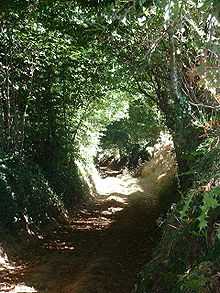Sunken lane

A sunken lane (also hollow way or holloway) is a road which has over time fallen significantly lower than the land on either side. They are created incrementally by erosion, by water and traffic. Some are very ancient with evidence of Roman or Iron Age origins, but others such as the Deep Hill Ruts in the old Oregon Trail at Guernsey, Wyoming developed in the space of a decade or two.[1]
Where ancient trackways have lapsed from use, the overgrown and shallow marks of hollow ways through forest may be the sole evidence of their former existence. On disused ridgeways in central Germany, the hollow ways often mark inclines.[2]
The earth banks on either side, sometimes topped with hedges and trees, give the impression of a tunnel enclosing the traveller. Because the roadway is restricted by the banks on either side, sunken lanes typically admit the passage of only one vehicle; that is, they are single track roads. Occasional passing places may be provided, but a meeting of vehicles in a sunken lane often requires one party to reverse to a suitable passing place. In Central Germany, "dual carriageways" have been observed with two trenches side by side where a trackway was in such heavy use that it had lanes dedicated for each direction.[3]
Up to the present day, some writers have assumed that low banks were deliberately created with shovels as a means to hem in cattle,[4] but there is no evidence for this, and in any case, banking only appears intermittently in certain types of soil. When metalled, sunken lanes are unlikely to erode any further down.
In the UK
Sunken lanes are a characteristic feature of the landscape of southern England, especially in the chalk areas of the North and South Downs, and greensand areas such as the Weald. Seal Hollow Road in Sevenoaks is a fine example of a sunken lane in southern England.
They are a particular feature of the West Country and west Wales - areas unaffected by the land enclosures of mediaeval England.[5]
While many sunken lanes are now metalled, some are still unsurfaced Green lanes, typically now designated as either Bridleways or Byways.
A sunken road is a cross country equestrian obstacle
-
The aptly named Hollow Lane, Canterbury, UK, joins the city to the Roman road, Stone Street
-

The old Roman road from Deva Victrix to Wilderspool, Newton Hollows, Cheshire, UK.
In Germany
One of the largest networks of such routes in Germany is to be found in the municipalities of Alsheim and Mettenheim in Rhineland-Palatinate, where there they make up over 30 km of hiking trails. Some of these sunken lanes can be up to 5 metres deep.
In the US
Aside from the Oregon Trail, sunken roads are found in states along the Atlantic seaboard, where European settlement began in the 17th century. In the Baltimore and Washington, D.C. areas, some sunken roads dating to that era have become busy suburban routes whose high embankments testify to their long history of traffic.
A sunken road played a major role in many military operations, such as the American Civil War battles at Antietam, Fredericksburg, and Shiloh.
In Galicia and Asturias

In Galicia and western Asturias the sunken lanes are usually called congostras or corredoiras, from Latin coangusta 'confined' and curro, currere 'run', being a common and characteristic feature of rural areas. Some lanes are now being recovered as hiking trails.
In Syria
In Syria, faint traces of hollow ways attest to a dense network of tracks or paths connecting Bronze Age sites with each other and with their cultivation zones in the fourth and third millennia BC, and thousands of kilometres of such routes have been surveyed.[6]
References
| Wikimedia Commons has media related to Sunken lanes. |
- ↑ Kreutzer, Lee (2008). "National Historical Trails: Across Wyoming, US National Park System" (PDF).
- ↑ Nicke, Herbert: Vergessene Wege, Nümbrecht, Martina Galunder Verlag, 2001
- ↑ Nicke, op.cit.
- ↑ Inglis, Harry RG: The Roads Leading to Edinburgh, PSAS, vol. 50, (1915-16), pps 18-49
- ↑ The Making of the British Landscape: How We Have Transformed the Land, from Prehistory to Today [Kindle Edition] Francis Pryor (Author)
- ↑ Raccidi, Mattia. "Wagons on the Move. The Study of Wagons through Landscape Archaeology". eTopoi Journal for Ancient Studies. Special Volume 3 (2012), pp. 405–410.
